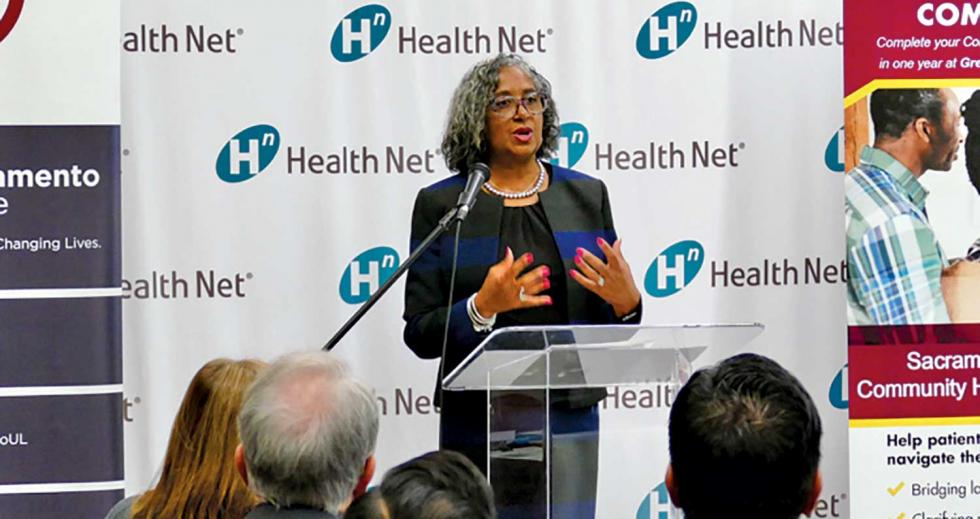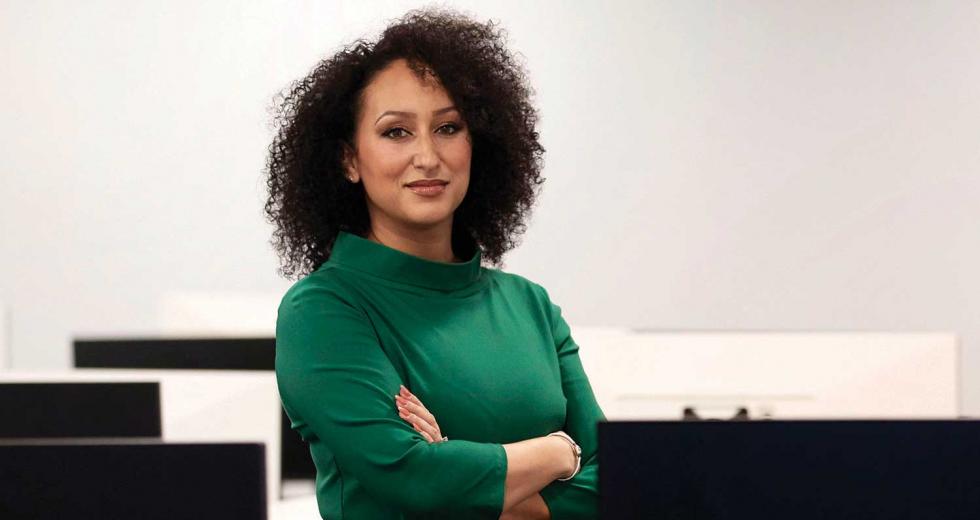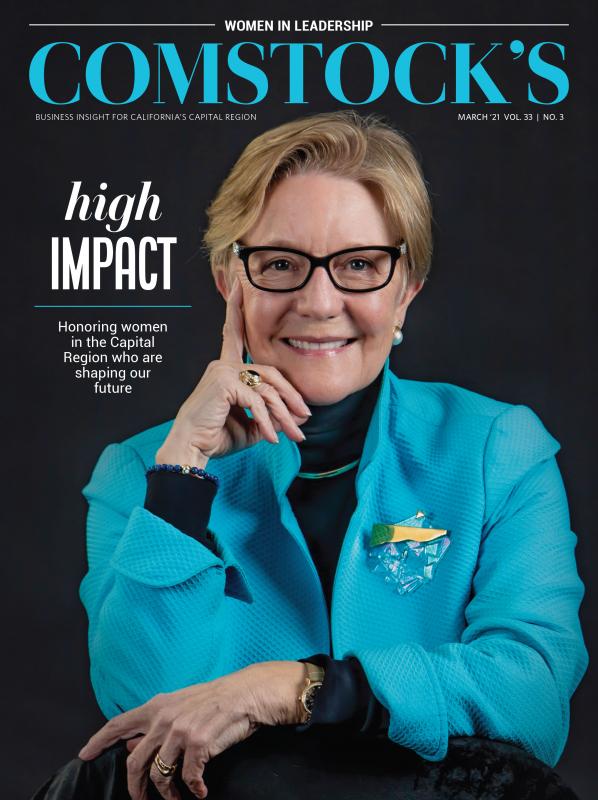As Tahira Cunningham sees it, intent matters, whether it’s on the subject of a nonprofit’s mission or its leadership structure.
On a recent weekday morning, Cunningham, chief of staff for Alluma, has just wrapped up a mentoring session with a young woman in her organization, an Oakland-based nonprofit with branches in Sacramento and Phoenix that provides technology solutions and consulting services to government agencies, nonprofits and other companies. “She just received a significant promotion, and I’m very excited for her, so I offered her some coaching as she grows into the organization,” says Cunningham, who is based in the Sacramento office that allows the company to have close contact with policymakers.
Cunningham’s guidance is purposeful by design. Mentorship and coaching are key to promoting women into higher positions at nonprofits, including those in the management realm. Nonprofits have a responsibility not just to intentionally improve outcomes for the communities they serve, she says, but also to look inward.
So how are nonprofits doing in that sphere? At first glance, nonprofits seem to be a more equitable space. For example, women occupy 45 percent of CEO positions at nonprofits (and make up 73 percent of the nonprofit workforce) in the United States, according to a 2018 report from The NonProfit Times, a publication that covers nonprofit management. In comparison, women make up only 8 percent of Fortune 500 CEOs, according to “Women CEOs in America,” a report from the alliance organization Women Business Collaborative and the nonprofits C200 and Catalyst.
The number of women leading nonprofits in the four-county Sacramento area (Sacramento, Yolo, Placer and El Dorado counties) is even more impressive. According to the Sacramento Region Community Foundation, 66 percent of the 611 nonprofits that participated in the Big Day of Giving in 2020 were run by women.
Between 2013 and 2016, the percentage of women in CEO roles at nonprofits increased across all budget groups, according to the “2020 Nonprofit Compensation Report” released by Candid, an organization that tracks data on nonprofits, foundations and grants. Break down the numbers, however, and it becomes clear there’s a considerable distance yet to go, particularly in larger nonprofit organizations. The bigger the budget, the greater the gender disparity, both in leadership positions and pay.
Nonprofits with budgets exceeding $25 million employ the fewest women in CEO positions. In 2018, women filled 42 percent of those roles in nonprofits with budgets of $5 million to $10 million. The number decreased to 37 percent in nonprofits with budgets of $10 million to $25 million and 33 percent for those with budgets of $25 million to $50 million. Meanwhile, in nonprofits with budgets at $50 million or more, women occupy only 25 percent of the positions, according to Candid data.
Still, statistics and personal stories suggest that, overall, women may find more growth opportunities at nonprofits, and as a result, many more are opting for this route.
Early in her career, Cunningham didn’t consider nonprofits as part of her professional path — growing up poor, she says, she wasn’t even familiar with the concept. Instead, she initially studied to become a psychologist. After graduating from Sonoma State, she moved to Sacramento and worked as a legislative assistant as she studied for her MBA from the University of Phoenix. Then came her moment of reckoning when the organization she worked for lobbied against an increase to the minimum wage.
It was an eye-opening time, says Cunningham, who decided to find a job that better aligned with her personal values. She says she viewed her remaining time with the firm as a valuable networking opportunity. “I learned how power works, and I learned how money works and influence works and how relationships work,” she says.
Cunningham soon moved into health care, working at nonprofits such as the California Pan-Ethnic Health Network and Sierra Health Foundation. It was in these jobs, pushing for reform, Cunningham says, that she realized what it means to enact change in a more deliberate and impactful way. “I was able to have conversations in which we said that health care reform wasn’t just about health care, it was about equity, it was about leveling the playing field,” Cunningham says.
“Working in the nonprofit sector as a woman of color, I feel like and have regularly felt like my perspective isn’t just encouraged, it’s required and valued.”
TAHIRA CUNNINGHAM Chief of staff, Alluma
That same ethos applies to positions within nonprofits as well, she says. The nonprofits she’s worked with, for example, use fellowship and internship programs to promote growth for women and people of color. “Working in the nonprofit sector as a woman of color, I feel like and have regularly felt like my perspective isn’t just encouraged, it’s required and valued,” she says.
Type of Nonprofit Matters
A nonprofit’s stated mission may affect career outcomes. Jodi Hicks, CEO and president of Planned Parenthood Affiliates of California, says she knows working for feminist, social-minded organizations has made a fundamental difference in her career. Case in point: Nationally, 90 percent of Planned Parenthood’s CEO positions are filled by women, Hicks says.
Hicks, whose resume includes positions as vice president of government relations of the California Medical Association and legislative director at the California chapter of the National Organization for Women, says how a nonprofit organization envisions and fills its positions, including leadership roles and board seats, has a tangible impact on its culture, which in turn strengthens its mission. “Depending on the type of nonprofit, the board makeup probably leans more toward women than in the private sector,” she says. “(And) having a more diverse makeup in terms of gender probably lends to more success.”
But progress can still be maddeningly gradual, she cautions. A board’s long-standing membership structure, for example, may hinder forward motion. “That makeup can certainly slow … (how fast) a culture changes,” she says.
Still, Hicks believes there’s a central reason more women are in executive positions at nonprofits compared to for-profit organizations. “Women are traditionally more community focused,” she says. And this is especially true at nonprofits. “There tend to be more women that sit on those boards who are willing to do communal work, so when there’s a search for candidates for leadership positions, there’s already more women,” Hicks says.
“There tend to be more women that sit on those boards who are willing to do communal work, so when there’s a search for candidates for leadership positions, there’s already more women.”
JODI HICKS CEO and president, Planned Parenthood Affiliates of California
Beth Hassett, the CEO of WEAVE, agrees. During her time in the nonprofit sector, she’s observed more women rise to the top at organizations with a social service mission because, traditionally, it’s often women in those so-called service jobs.
Hassett’s background includes fundraising as the director for Mercy San Juan Community Council and director of marketing at Capital Public Radio. She’s worked at WEAVE, which provides crisis intervention services for domestic violence and sexual assault victims and has a $10 million annual budget, since 2006.
Hassett says her fundraising experience makes her something of an anomaly in the leadership realm at nonprofits with a focus on domestic violence and sexual assault issues. In these organizations, she says, executives often climb the ladder via direct service positions, such as therapist or social worker. She says nonprofits need to do better when it comes to promoting women in executive positions. Most don’t offer employees a clear path toward moving up the ladder, Hassett says, and that’s an inherent management flaw.
“I don’t know if the people hiring the person at the top always know what they’re doing,” she says. “We don’t spend as much time thinking about grooming that next group of people for leadership roles.”
The coronavirus crisis, Hassett adds, is a stark reminder to think to the future with care. When the pandemic hit, she immediately started thinking about leadership succession at WEAVE. Compared to companies in the for-profit sector, Hassett says, nonprofits tend to fall short in such contingency planning. “We (don’t) do enough work around that kind of thing — thinking about who the next leader is. Are we bringing them up through the ranks, or are we just going to go pluck somebody from somewhere else?” Hassett says the pandemic “has increased my awareness about how challenging change and uncertainty is for many of my staff at all levels of the organization.”
Cassandra Jennings, president and CEO of the Greater Sacramento Urban League, shares a similar perspective. “It can be difficult to have a clear path of succession planning within an organization if you’re not big enough,” Jennings says.
Cassandra Jennings, president and CEO of the Greater Sacramento
Urban League, says nonprofits must do better at identifying and
seeking out candidates for promotion. (Photo courtesy of Health
Net)

The smaller the organization, she says, the more specific each person’s job tends to be, which means she may not be suited to a position that requires an overarching understanding of how all operations work.
Jennings has spent more than 50 years working in the private, public and nonprofit sectors, including a gig as adviser to Kevin Johnson when he was mayor of Sacramento. Jennings also spent six years as the assistant city manager for the City of Sacramento and 18 years with Sacramento Housing and Redevelopment Agency, including six years as deputy executive director.
Nonprofits, she says, must do better in looking beyond day-to-day operations. “We get money for the programs, but we don’t get money for the planning, for advocacy, for capacity building,” Jennings says. To counter this, board members should actively identify and seek out candidates for promotion. “Progress must come from both the inside and outside,” she says.
Continuing to Make Strides
Progress doesn’t always come easy, however. Liv Moe, executive director of Verge Center for the Arts in Sacramento, says she faced some ageism when her nonprofit arts institution merged with the Center for Contemporary Art Sacramento in 2014. Despite being Verge’s founding director since 2008 and keeping the center afloat during a recession, one board member who left before the merger made it clear he thought Moe was too young to be successful as the director of the newly formed nonprofit. “There was actually a debate (among board members) about … whether I’d be the new director,” she says.
Moe prevailed and resolved to put the experience, which she found both sexist and ageist, behind her. “It doesn’t serve me to be angry about it. … To some degree, it’s somewhat predictable given how misogynistic our society is,” she says.
Today, Verge, which has an annual $750,000 budget, is run largely by women. Moe’s perspective on this doesn’t just mirror others, it reinforces data that women are more likely to thrive and move upward in nonprofits with smaller budgets. “It’s the nature of the field,” she says. “In (nonprofits) that are smaller or social service oriented, you’re more likely to see female directors in those (leadership) roles.”
Moe says more nonprofits, whatever their mission or size, should commit to enhanced mentorship and leadership opportunities for women because it’s critical for nonprofit success. “One of the most important things you can do is support and promote other women,” she says.
Or, as Hicks puts it: “What leads to more women in leadership is more women in leadership.” Organizations must be deliberate in creating change, Hicks adds, echoing others’ calls for deliberate practices. “There has to be an intentionality.”
For Cunningham, this means creating deliberate spaces for others via mentoring and fellowships, casual chats, and formal networking. “It’s a conversation about being at the table,” Cunningham says. “It’s a conversation about who’s setting the table, it’s a conversation about how your voice matters.”
–
Get all the profiles in our annual salute to women in leadership delivered to your inbox: Subscribe to the Comstock’s newsletter today.
Recommended For You

We’ve Certainly Come a Long Way
Comstock’s president and publisher considers the ways women have been leaders throughout history.

Laying the Groundwork
A widespread effort to achieve environmental justice in Sacramento is gaining momentum
Proponents say environmental justice efforts will only be successful if they are inclusive and equitable.

Taking a Bite Out of Inequality
Local giving circle empowers women and girls around the world
How one nonprofit uses education to encourage action on behalf women and girls around the world.

Wonder Women
Comstock’s celebrates six extraordinary women of influence who are redefining leadership on their own terms.
We’re highlighting six of the Capital Region’s most influential female leaders who are blazing trails in their respective industries.




